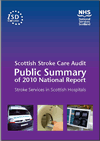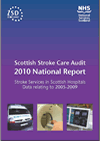Scottish Stroke Care Audit:
2010 National Report
Stroke Services in Scottish Hospitals.
Data relating to 2005 - 2009.
Paper editions of the above are available, please contact Hazel Dodds for a copy.
SSCA National Report Tables and Charts (only available on-line)
SSCA Hospital Tables - Inpatients (only available on-line)
SSCA Hospital Tables - Outpatients (only available on-line)
INTRODUCTION
There is strong evidence that well organised stroke care improves the outcome of patients having a stroke. In Scotland, the Scottish Intercollegiate Guidelines Network (SIGN) and NHS Quality Improvement Scotland (NHS QIS) have developed guidelines and standards aimed at delivering that care. New NHS QIS standards for stroke were published in June 2009.
The Scottish Stroke Care Audit monitors the quality of care provided by the hospitals in all NHS Boards by collating data collected by the Managed Clinical Networks (MCNs). These data are used by the Scottish Government Health Department to monitor progress against the NHS QIS standards for stroke and the Better Heart Disease and Stroke Care Action Plan also published in 2009.
NHS Boards are expected to identify aspects of their stroke services which do not meet National Standards and to work with their stroke MCNs to improve their performance.
The 2010 National Report includes data describing the quality of stroke care in each acute hospital grouped by NHS Board from 2008 to 2009. This allows each hospital and NHS Board not only to compare their performance with national standards, but also with other organisations. Hospitals with less satisfactory performance can learn from those where services are of higher quality. This year the report includes case studies demonstrating how improvements have been made in relation to management of mini strokes (transient ischaemic attacks) and Appendix A contains submissions from all fourteen boards sharing and outlining their MCNs plans to improve performance against NHS QIS standards in their local area.
This year's report also includes trend analysis presenting data from
2005-2009 for Scotland overall which demonstrates improvement in performance
against the current NHS QIS standards.
![]() Back
to top
Back
to top
KEY POINTS
Five key quality indicators are:
Proportion of stroke patients admitted to a Stroke Unit on day
of admission and within 1 day of admission to hospital. Evidence
suggests that stroke unit care is associated with fewer deaths and less
residual disability after a stroke. The current NHS QIS standard is that
at least 60% of patients should be admitted to a stroke unit on day of
admission to hospital (Day 0) and 90% by the day following admission to
hospital (Day 1). In 2009 37% (2008 - 35 %) of patients were admitted
to a stroke unit on Day 0 and 61% (57%) by Day 1.
The trend analysis from 2005-2009 demonstrates that the percentage of
stroke patients admitted to a Stroke Unit on Day 0 has increased from
28% to 37% and on Day 1 from 49% to 61%. There has also been a significant
improvement in the number of patients admitted to a Stroke Unit at any
time during their admission, an increase from 71% to 81%.
![]() Back
to top
Back
to top
Proportion having a documented Swallow screen on day of admission. About half of all stroke patients will not be able to swallow safely on admission to hospital. If given fluids or food inappropriately patients may develop, and possibly die from, pneumonia and if not treated appropriately they may become dehydrated and malnourished which may lead to slowed recovery and/ or worse outcome.
The current NHS QIS standard is that all patients should have a swallow
screen on the day of admission. In 2009 61% (2008: 55%) of patients had
a swallow screen recorded on the day of admission. The trend analysis
from 2005-2009 demonstrates that the percentage of stroke patients receiving
a swallow screen on the day of admission has increased from 47% to 61%.
Proportion having a brain scan on day of admission. A
brain scan is essential to confirm the diagnosis of stroke and to distinguish
stroke due to ischaemia (a blocked blood vessel) or a haemorrhage (burst
blood vessel). Treatments for a blocked blood vessel are very dangerous
to those with a burst blood vessel, e.g. Aspirin. The current NHS QIS
standard is that at least 80% should have a brain scan on the day of admission.
In 2009 49% (2008: 42%) of patients had a brain scan on the day of admission.
The trend analysis from 2005-2009 demonstrates that the percentage of
stroke patients having a brain scan on the day of admission has increased
from 27% to 49%.
![]() Back
to top
Back
to top
Proportion of patients with ischaemic (a blocked blood vessel)
stroke who receive aspirin within 48 hours of admission. As
noted above only patients with ischaemic stroke should be given aspirin.
It would be very dangerous to give patients with a stroke caused by a
burst blood vessel aspirin therefore aspirin is not given until the patient
has had a brain scan to determine the type of stroke. If there are delays
to brain scanning this will cause a delay in aspirin prescribing.
Aspirin started within the first 48 hours reduces the proportion of patients
having recurrent strokes and residual disability. The NHS QIS standard
is that all patients should receive aspirin on the day of admission or
the day after unless contraindicated. In 2009 68% (2008: 67%) of ischaemic
stroke patients received aspirin within 48 hours of admission. The trend
analysis from 2005-2009 demonstrates that the percentage of stroke patients
receiving aspirin on the day of admission or the day following admission
has increased from 41% to 68%.
Proportion of patients with a mini stroke, who do not need immediate
admission, assessed in a specialist neurovascular clinic within 7 days
of receipt of referral. The average risk of a stroke after a
mini stroke is approximately 10% in the first week and for certain sub-groups
may be as high as 30%. Early recognition, diagnosis and initiation of
secondary prevention are likely to prevent many more strokes if started
immediately after the initial mini stroke.
The NHS QIS standard is that 80% should be seen within 7 days from referral.
In 2009 80% (2008: 58%) of patients seen in neurovascular clinics were
seen within 7 days. The trend analysis from 2005-2009 demonstrates that
the percentage of stroke patients seen within 7 days from referral has
increased from 30% to 80%.
![]() Back
to top
Back
to top
INTERPRETATION
Good or bad performance with respect to these five indicators will usually
reflect the actual performance of the service. However, if the audit methodology
is not strictly adhered to, the local data may be misleading - most likely
they will give a reassuringly good measure of performance. For instance,
if the audit does not include patients managed outwith the stroke unit
an overly optimistic view of the quality of the service will result. It
should be noted that in November 2009 we created for the first time a
national database so calculations in this year's report may not match
exactly those presented in previous reports.
For individual hospitals (and the trend analysis) these data are presented
in charts. Further detailed charts and tables are available at the top
of this page.
DETAILED FINDINGS
The quality of stroke services varies greatly across Scotland. Further
action is required in all NHS Boards since areas of poor performance are
likely to be reflected in worse outcomes (more deaths and more disability)
for their patients. In addition, poor care leads to longer lengths of
hospital stay, greater residual dependency and thus higher costs to health
services. No hospital meets all of the NHS QIS standards, so all need
to strive to improve their stroke services.
![]() Back
to top
Back
to top
The Better Heart Disease and Stroke Care Action Plan published in June 2009 highlights many additional aspects of stroke services which need to be developed.
The revised and more challenging NHS QIS stroke standards also published in June 2009 reflect the latest evidence included in the latest stroke SIGN guidelines and include new standards relating to thrombolysis and carotid endarterectomy:
- Thrombolysis will be administered according to SIGN guidelines to at least 5 per 100,000 population per year and that 80% of treated patients should start treatment within 60 minutes of arrival at hospital
- 80% of patients undergoing carotid endarterectomy for symptomatic carotid stenosis have the operation within 14 days of the stroke event
The numbers (percentage) of stroke patients thrombolysed in 2008 and 2009 were 260 (3%) and 411 (5%) respectively. These numbers equate to 5 patients per 100,000 persons in 2008 and 8 patients per 100,000 persons in 2009. The 2011 report will present numbers thrombolysed and door to needle times.
It was agreed to pilot the Carotid Intervention aspect of the audit in
two centres and an update is included in this report.
![]() Back
to top
Back
to top
MAIN CONTACTS:
Martin Dennis
SSCA Clinical Lead
0131 537 1719
martin.dennis@ed.ac.uk
Hazel Dodds
SSCA Clinical Coordinator
0131 275 7184
hazeldodds@nhs.net
David Murphy
Senior Information Analyst
0131 275 6624
david.murphy2@nhs.net

